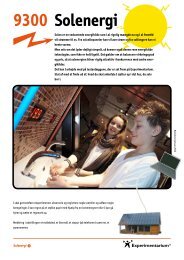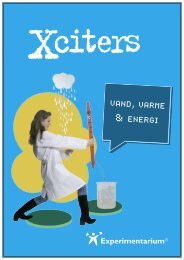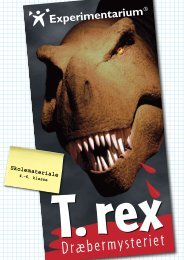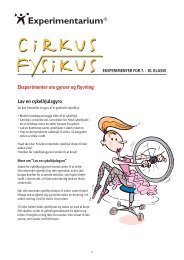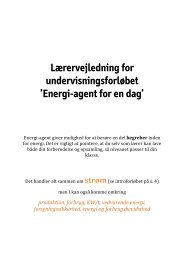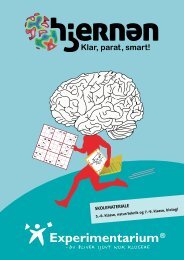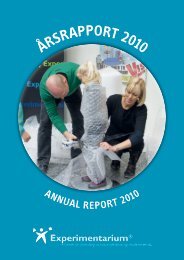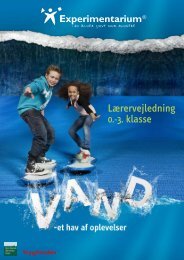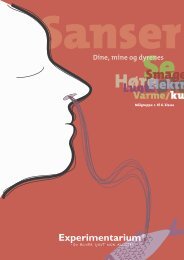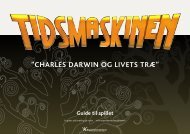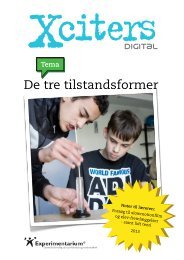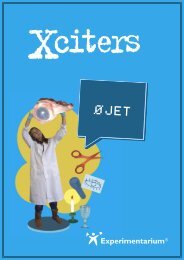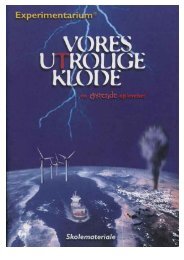Experimentarums årsberetning 2004 - Experimentarium
Experimentarums årsberetning 2004 - Experimentarium
Experimentarums årsberetning 2004 - Experimentarium
Create successful ePaper yourself
Turn your PDF publications into a flip-book with our unique Google optimized e-Paper software.
ANNUAL REPORT <strong>2004</strong><br />
A YEAR CHARACTERISED BY A HIGH LEVEL OF ACTIVITY<br />
With four exhibitions, 337,746 visitors and many new educational<br />
offers for schools, <strong>2004</strong> was a year characterised by a very high level<br />
of activity.<br />
CONCLUSION OF THE RENEWAL OF THE EXPERIMENTARIUM’S<br />
MAIN EXHIBITION<br />
On 29 January <strong>2004</strong>, the Minister for Science, Technology and<br />
Innovation, Helge Sander, inaugurated “Circus Fysikus”, which<br />
marked the conclusion of the renewal of the <strong>Experimentarium</strong>’s main<br />
exhibition. Visitors to this exhibition can travel on a flying carpet<br />
(helped along by compressed air) and, as fakirs, can lie on a bed of<br />
1,000 nails. The exhibition’s experiments deal with the forces of nature,<br />
and demonstrate the often surprising effects that these forces often<br />
produce.<br />
The renewal of the <strong>Experimentarium</strong>’s main exhibition has cost a total<br />
of approximately DKK 22 million, of which DKK 17 million was derived<br />
from grants from foundations and companies. The <strong>Experimentarium</strong><br />
would like to express its thanks to these foundations and companies,<br />
whose generous support made this very important project possible:<br />
the Egmont Foundation, the Augustinus Foundation, the Novo Nordisk<br />
Foundation, the Lundbeck Foundation, the Knud Højgaard Foundation,<br />
the Louis Petersen Scholarship Fund, the Oticon Foundation,<br />
Novozymes A/S, the Thomas B. Thrige Foundation, the Obel Family<br />
Foundation, the Hartmann Brothers Foundation, Icelandair, the Danish<br />
Energy Authority, NCC Danmark, DEFU and the Copenhagen Health<br />
Administration.<br />
SAFRI DUO BROUGHT SUCCESS TO THE SCHOOLS<br />
COMPETITION “GI’ LYD” (“MAKE A SOUND”)<br />
In 2003, with support from the Otto Mønsted Foundation, the<br />
<strong>Experimentarium</strong> launched a competition for Danish schools which<br />
invited proposals for the most exciting experiments with sound.<br />
Inspirational material was also prepared for teachers. 117 classes took<br />
part, and a total of 85 different experiments were received. Somewhat<br />
complacently, the <strong>Experimentarium</strong> was under the impression that<br />
the school classes could not suggest experiments with which we were<br />
not already familiar. Accordingly, it was a pleasant surprise to see just<br />
how much imagination and ingenuity the classes invested in their<br />
experiments. The winning proposal was a wonderful machine which<br />
caused a water surface above a<br />
loudspeaker to produce a very<br />
beautiful water droplet<br />
dance whenever a note<br />
was played on an<br />
electric organ. The<br />
final round of the<br />
competition was<br />
spiced with a<br />
fantastic concert<br />
by Safri Duo,<br />
who personified<br />
the competition<br />
in relation to the<br />
pupils. The winning<br />
class received a week’s<br />
trip to Paris, sponsored<br />
by the KILROY group travel.<br />
THE GREAT SEXPERIMENT<br />
On 30 September, Minister of Education, Ulla Tørnæs, opened a special<br />
exhibition entitled “The Great sEXPERIMENT”, which was on loan<br />
from Technopolis in Flanders. In the exhibition, the public investigates<br />
whether men or women are best at performing various tasks. The 40<br />
exhibits can be started up using a bar code on an armband, which is<br />
supplied in women’s and men’s versions. At the end of the exhibition,<br />
visitors use their armbands to obtain a printed “scorecard” stating how<br />
well the person concerned performed in each of the experiments in<br />
relation to previous visitors – with the total scores for men and women<br />
displayed separately.<br />
For the traditional school materials which are always compiled for<br />
new exhibitions, the <strong>Experimentarium</strong> also explored new ground here,<br />
inasmuch as the material was available in cyberspace only! On the<br />
other hand, the materials gave teachers and students a sound basis<br />
upon which to learn about common prejudices concerning men’s and<br />
women’s abilities and habits.<br />
When approximately 70,000 men and women had participated in the<br />
exhibition tests, the results were summarised. There were only a very<br />
few tasks in which a marked difference could be detected between the<br />
results of men and women.<br />
“The Great sEXPERIMENT” took over the stage from “CreepyCrawly”,<br />
which had been on display in Special Exhibition Room 1 since<br />
September 2003.<br />
CONFERENCE ON THE BRAIN AND LEARNING<br />
The special exhibition “The Brain” continued to challenge the public<br />
in Special Exhibition Room 2 throughout the year. As a supplement to<br />
this, and in connection with the International Week of the Brain, the<br />
<strong>Experimentarium</strong>, in co-operation with the Greater Copenhagen Centre<br />
for Higher Education, held a successful conference on 10 and 11 March<br />
entitled “The Brain and Learning”, which attracted 250 participants.<br />
DEBATE EVENINGS IN CO-OPERATION WITH FOF<br />
In the course of the year, the <strong>Experimentarium</strong> held a total of seven<br />
debate evenings in association with the adult education association<br />
FOF. The subjects, which were intended to be slightly controversial,<br />
were: Modern management and school development: Expansion of<br />
consciousness or new-religious nonsense? Is intelligence inherited?<br />
Mobile telephones, radiation and magnetic fields – how much do we<br />
know in the interface between science and society? IT and security.<br />
Can faith move mountains? Gender, biology and upbringing. Why are<br />
women less attracted by science than men?<br />
¬ 7



